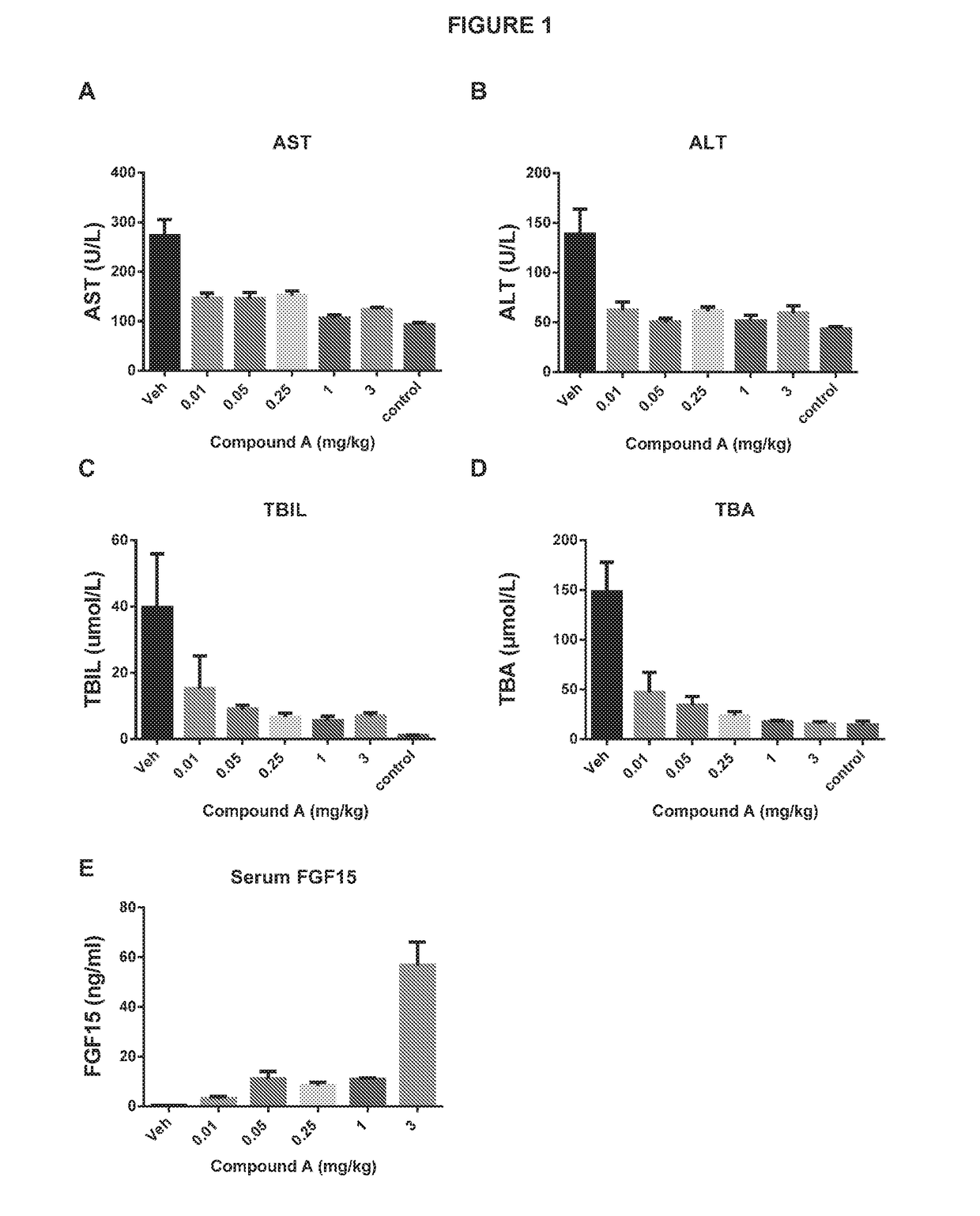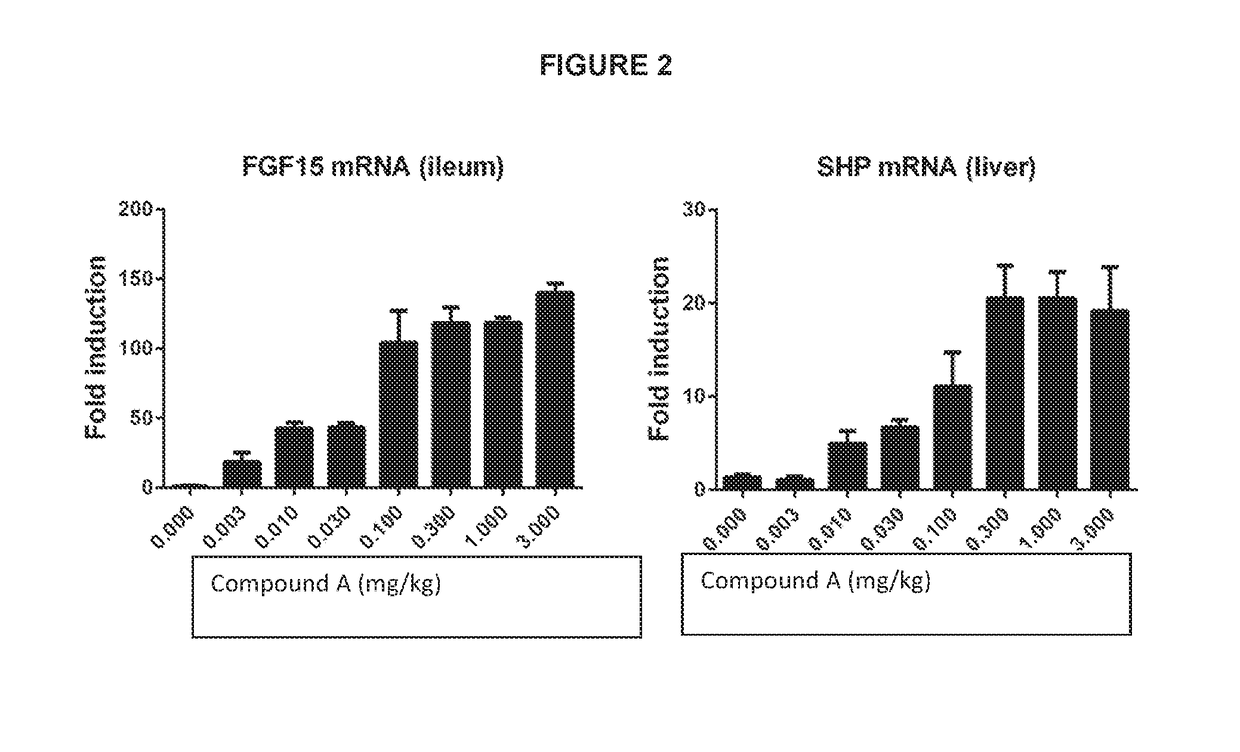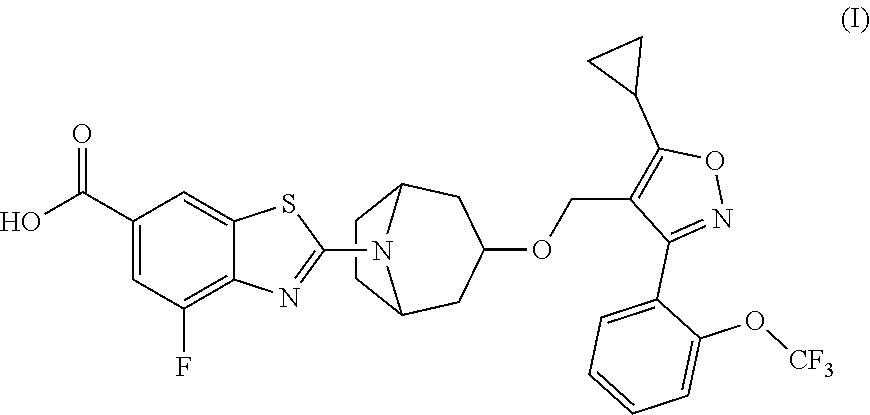Methods for using fxr agonists
- Summary
- Abstract
- Description
- Claims
- Application Information
AI Technical Summary
Benefits of technology
Problems solved by technology
Method used
Image
Examples
example 1
Effect of Test Compound in Chronic Treatment Rat ANIT Model
[0092]Compound A was evaluated in a chronic treatment model of cholestasis over a range of doses from 0.01 to 3 mg / kg.
[0093]Rats were treated with alpha-naphthyl-isothiocyanate (ANIT) (0.1% w / w) in food for 3 days prior to treatment with the compound at the indicated doses or with vehicle control (“Veh”). A non-cholestatic control group was fed standard chow diet without ANIT, and serve as the non-cholestatic control animals (“Control”), After 1 μg days of oral dosing, the indicated analyte was measured in serum. LLQ, lower limit of quantitation. Mean±SEM; n=5.
[0094]ANIT treatment caused elevation of hepatobiliary injury indicators, such as elevated levels of circulating aspartate aminotransferase (AST) (FIG. 1A), alanine aminotransferase (ALT) (FIG. 1B), bilirubin (FIG. 1C) and bile acids (FIG. 1D) (“Veh” vs “Control”). These data demonstrate that ANIT exposure induced profound cholestasis and hepatocellular damage. In cont...
example 2
[0097]The efficacious concentration of Compound A was determined by PK / PD modeling from the rat ANIT-induced cholestasis chronic treatment model.
[0098]Male Wistar rats were treated with ANIT (0.1% ANIT in chow diet) for 2 weeks. The treatment of Compound A (0.01, 0.05, 0.25, 1 and 3 mg / kg, n=5 / group) was initiated 3 days after disease induction by ANIT. The serum samples were collected on day 14 for analysis of biomarkers of hepatobiliary injury (including ALT, AST, bilirubin and bile acids). The PK samples (pre-dose, 0.5, 1, 3, 7, 10 and 24 h, n=3 / dose group) were taken on day 13 (at steady-state). AUC0-24h was determined using Phoenix WinNonlin 6.3 software and the average concentrations were calculated from mean of AUC0-24 h at each dose (divided the AUC0-24 h by 24 h). The mean biomarker data were compared to the PK data (average concentration at each dose) for the modeling. The IC80 was determined using the Inhibitory effect Imax model (effect C=0 at Imax, C=infinity at E0) bui...
example 3
[0099]The efficacious concentration of Compound A was determined by PK / PD modeling from the rat ANIT-induced cholestasis chronic treatment model described in Example 1. The PK samples (pre-dose, 0.5, 1, 3, 7, 10 and 24 h, n=3 / dose group) were taken on day 13 (at steady-state). AUC0-24 h was determined using Phoenix WinNonlin 6.3 software and the average concentrations were calculated from mean of AUC0-24 h at each dose (divided the AUC0-24 h by 24 h). The individual biomarker data were compared to the PK data (average concentration at each dose) for the modeling. Since the lowest dose (0.01 mg / kg) already approached maximal efficacy, the IC80 was chosen as the measurement of the efficacious exposure (Table 1). The IC80 was determined using the Inhibitory effect Imax model (effect C=0 at Imax, C=infinity at E0) built in Phoenix WinNonlin 6.3 software. From these calculations, the average efficacious concentration of Compound A at Cmax can be estimated as 0.127 ng / ml and the AUC0-24 h...
PUM
| Property | Measurement | Unit |
|---|---|---|
| Time | aaaaa | aaaaa |
| Mass | aaaaa | aaaaa |
| Mass | aaaaa | aaaaa |
Abstract
Description
Claims
Application Information
 Login to View More
Login to View More - R&D
- Intellectual Property
- Life Sciences
- Materials
- Tech Scout
- Unparalleled Data Quality
- Higher Quality Content
- 60% Fewer Hallucinations
Browse by: Latest US Patents, China's latest patents, Technical Efficacy Thesaurus, Application Domain, Technology Topic, Popular Technical Reports.
© 2025 PatSnap. All rights reserved.Legal|Privacy policy|Modern Slavery Act Transparency Statement|Sitemap|About US| Contact US: help@patsnap.com



